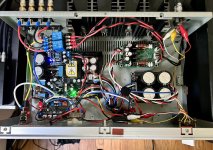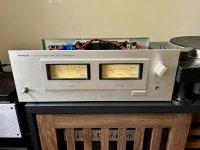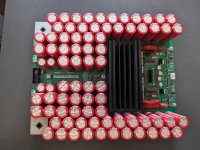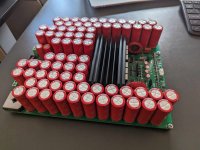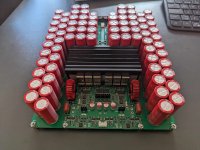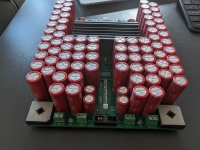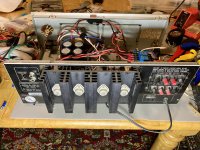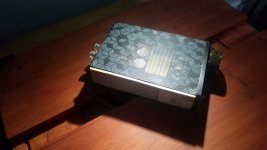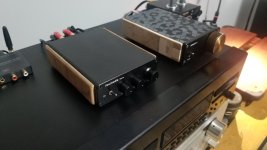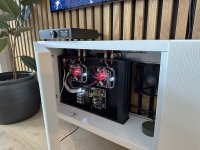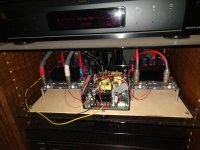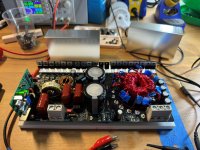Class D of the Week!
It sounds very good! I however think I like the MonoAmps better. The jury’s still out.
- IcePower 300A2
- MicroAudio SMPS630-G
- Additional capacitors (2*10000uF per rail) between SMPS and amplifier, also from MicroAudio
- 300A2 wiring harness set from Ghent Audio
- UPC1237 speaker protection board and power meter driver board from Amazon
It sounds very good! I however think I like the MonoAmps better. The jury’s still out.
Attachments
Last edited:
Production of our Power Amplifier boards have been delayed due to chip shortage. But finally they arrived 🙂
Key specifications:
Features onboard:
Power Supply requirements:
2 x 40VAC Transformer - Main power
2 x 12VAC Transformer - Aux power
No chinese chip amp or application note designs. This is ALL DIY made from scratch in Denmark.
Key specifications:
- 2x400 watt @ 4 ohm
- Peak output current > 30A
- Output noise level < 25uV
- Output impedance < 20uΩ
- Approx 95.000uF Low ESR High Quality capacitors onboard.
- 5th order differential modulator.
- Board size: 180x230mm
Features onboard:
- 2 channel class-D amplifier.
- Discrete non-feedback class-A input buffer.
- Shunt regulators for input buffer.
- Fully DC coupled design.
- High quality components selected for audio performance.
- Local de-coupling capacitors for all supply rails. Solid polymer capacitors for input stage.
- Comprehensive supervisory circuit for optimum protection. (short circuit, temperature, over/under-voltage and high frequency).
- Heatsink adequate for normal operating conditions.
- Add-On bay. The amp can be fitted with a onboard DAC or PreAmp.
Power Supply requirements:
2 x 40VAC Transformer - Main power
2 x 12VAC Transformer - Aux power
No chinese chip amp or application note designs. This is ALL DIY made from scratch in Denmark.
Attachments
Last edited:
My 300A2 amp-in-a-vintage-chassis sounds REALLY good. Every once in a while this week I've had to stop and pay attention when a good recording in FLAC has come through while I'm working. I'm within my rights as the builder to think the unconnected Hitachi lateral TO3s on the back are adding a little something special. 😉
Attachments
D
Deleted member 148505
Hypex Nilai500DIY
Had to improvise to make it fit into a wall mounted BESTÅ cabinet from IKEA (WxHxD: 56x32x20 cm):
Had to improvise to make it fit into a wall mounted BESTÅ cabinet from IKEA (WxHxD: 56x32x20 cm):
- 90 degree banana plugs and XLR's.
- External standby switch, the amp is resting on the front plate where it originally was.
- Removed the top cover for those nice LED's, an accidental PSU touch just clears my ears.. /s
- Adjustable voltage regulator in the green box to control the USB-powered exhaust fan.
Attachments
I suppose you build the Nilai 2x250W stereo kit offered by Hypex. What speakers do you drive with these amps?
Thought I shared this build here too. 6ch amp /w DSP
-3pcs 2ch TPA3255 PFFB boards from 3e-audio
-FreeDSP Aurora
-SMPS800RS power supply
-Chassis is made from 1.5mm steel and the enclosure is from carbon fiber (this took waaaaay too many hours to make).
If someone is wondering why only 800W power supply for 6x260W amps: this thing is made for LX Minis + 2 subs, so this is really an overkill for them.
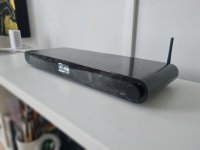
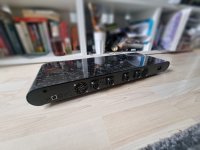
-3pcs 2ch TPA3255 PFFB boards from 3e-audio
-FreeDSP Aurora
-SMPS800RS power supply
-Chassis is made from 1.5mm steel and the enclosure is from carbon fiber (this took waaaaay too many hours to make).
If someone is wondering why only 800W power supply for 6x260W amps: this thing is made for LX Minis + 2 subs, so this is really an overkill for them.


This is a very interesting thread. How hard is it to build your own class-D multi-channel amp? - My knowledge of electronics is very basic. Any crystal clear step by step instructional references on diyAudio?
I have read that the PSU has a significant effect on the amp, can someone explain that in normal english 🙂 ?
Also, I've done a bit of reading on GaN based amps which seem to be gaining momentum, anyone with any insight into this technology?
I have read that the PSU has a significant effect on the amp, can someone explain that in normal english 🙂 ?
Also, I've done a bit of reading on GaN based amps which seem to be gaining momentum, anyone with any insight into this technology?
GaN was designed for high power high speed (nano second switch) applications - like for telecom radio power amplifiers. I don’t see any real advantages in the audio realm and the ones I heard thus far, have not sounded better than current state of the art silicon technology such as that in TPA32xx or MA12070, IRS2092, etc. or integrated solutions like IcePower. Mostly it’s about newness and bragging rights to claim one has GaN technology.
Me neither, also the smaller part argument doesn't make sense, since the bulk of any PCB is being taken by other things like capacitors, connectors, controller and inductors/coils.I don’t see any real advantages in the audio realm and the ones I heard thus far, have not sounded better than current state of the art silicon technology
The only benefit could be that the switching frequency could be a little higher.
But that very quickly becomes in the realm of diminishing returns.
Standard MOSFET technology is fine switching around 400-1000kHz.
Maybe in the ultra high power applications (> 2kW) it might be helpful with power dissipation.
It's really really easy......how much power do you think you need? The TI TPA3255/3251's (and there are plenty of others) perform really well and are affordable.This is a very interesting thread. How hard is it to build your own class-D multi-channel amp? - My knowledge of electronics is very basic. Any crystal clear step by step instructional references on diyAudio?
I have read that the PSU has a significant effect on the amp, can someone explain that in normal english 🙂 ?
Also, I've done a bit of reading on GaN based amps which seem to be gaining momentum, anyone with any insight into this technology?
Buy a couple of boards (if you want 4 channels, more if you need more channels) and pick up a 48V switching power supply...meanwell makes some great ones that are really affordable. The TPA3255 is rated at 150W per channel, but that's a little optimistic (depends on how much distortion you can live with) but even with a usable 50-60W it's plenty for most people. That being said you don't really need a 600W (150W x 4 channels) power supply but it doesn't hurt to have an oversized supply.
One thing with running multiple boards off of a single power supply is that you can get a low freq beating noise in the speakers; there are settings on the boards to make one the master and the remainder slaves to eliminate this. You have to run wires between the boards and change some jumpers but it's quite straightforward.
Build a breadboard by screwing everything to a piece of plywood and get it running.....cut a power cord off of an old vacuum cleaner or whatever and you are just about done. You wire the AC in and the DC out to the boards.
Making the case is by far the biggest challenge, or you can just buy one....... Like many folks here sometimes the breadboard hangs around for a few years in your system..it's all fun.
Here's my TPA3255 4 channel system used all day long every day when I'm home..still bolted to plywood.
Attachments
95% of my amps are “plank amps”. They have to be very special or a commercial project to finally get a case. I have maybe 5 amps in a real chassis/case and the rest are on plywood or MDF. The plank amps still sound great though.
Here is one of my latest cased amps with 1200AS2 core and my own tube buffer:


Here is one of my latest cased amps with 1200AS2 core and my own tube buffer:
Last edited:
Hi X,
cool amp! Just a question re hum: many reviewer report an acoustic hum caused by the psu transformer (not through the speaker, the transformer itself makes hum/buzz). What's your experience with that issue and how disturbing is it, if any?
cool amp! Just a question re hum: many reviewer report an acoustic hum caused by the psu transformer (not through the speaker, the transformer itself makes hum/buzz). What's your experience with that issue and how disturbing is it, if any?
Good one 💪🏻 Ice Power modules to me sound good only with tube input stage.95% of my amps are “plank amps”. They have to be very special or a commercial project to finally get a case. I have maybe 5 amps in a real chassis/case and the rest are on plywood or MDF. The plank amps still sound great though.
Here is one of my latest cased amps with 1200AS2 core and my own tube buffer:
View attachment 1218601
View attachment 1218602
Hi Plott,Hi X,
cool amp! Just a question re hum: many reviewer report an acoustic hum caused by the psu transformer (not through the speaker, the transformer itself makes hum/buzz). What's your experience with that issue and how disturbing is it, if any?
I have had some mechanical hum on toroidal transformers. They are very sensitive to DC in the mains. Try a DC blocker setup.
This is my 2nd irs2092s build, the class D section is based off the iraudamp9 reference design with some minor changes. I built the power supply side and the crossover card.
Yesterday I was running into issues and blew up $80 in output FETs/irs2092 drivers 😅
Yesterday I was running into issues and blew up $80 in output FETs/irs2092 drivers 😅
Attachments
- Home
- Amplifiers
- Class D
- Class D Amp Photo Gallery
